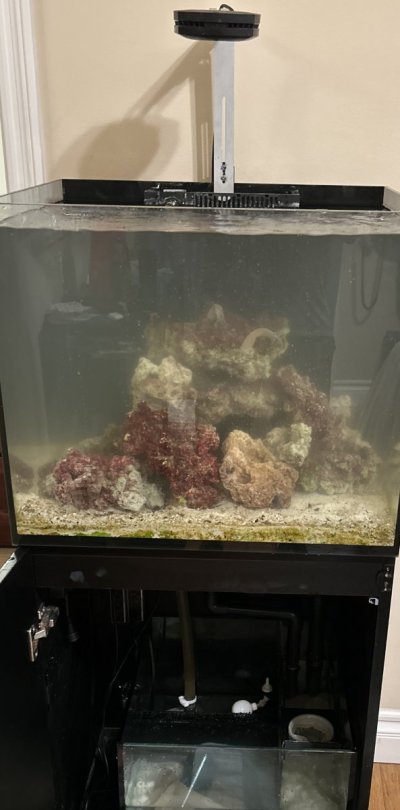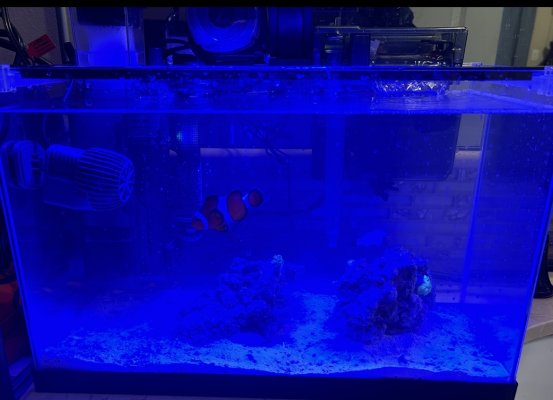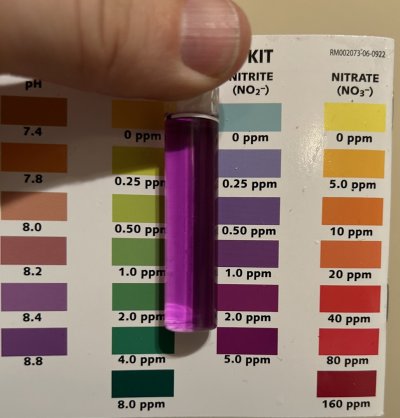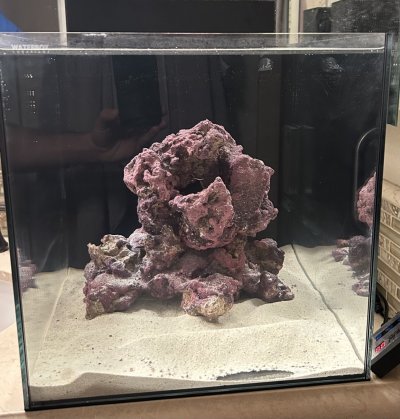About 2 months ago, I had my first start to setting up a saltwater aquarium. Reading through the forums, I took my chance on a used set up and looked for around 40 gallons. I had spent a few weeks prior doing research and had listed out equipment that I thought could help me kick off my first reef tank.
I ended up buying a Red sea Reef 170 with sump. The seller gave me his whole set up which included an AI prime HD 16, kraken lid, Ice Cap K2-50 skimmer, Jebao cross flow wave pump, and a Sicca Synca 3.0 return pump. The guy was nice enough to give me salt and net. The only challenge was that the tank held 2 clown fish, sand and reef rock. My first impression was that this was a steal for $800.
I made a quick purchase and took everything home. He gave me 3 buckets to help transport reef rock, sand and water. Once home, I realized that the weight of the tank was concerning in the place I wanted to put the tank. To buy myself some time I filled the tank halfway, gave it some water movement, and bought a 5 gallon tank, heater and filter to hold the fish for a few days while I figured things out.
The AI prime wasn’t working day 1, so I ran back to Petco and bought a light. I also started to get test kits because I was worried about the 2 clown fish. The ammonia level was off the charts, so I spent the next week doing twice daily water changes, testing non stop, and trying to build back a biofilter by dosing Seachem prime, pristine and stability. About a month later, I finally went through the cycle. I was very confused during the cycle because I used his sand, rock and bioballs which were over a year old and should have had some bacteria since everything was kept in moving water. I even found nitrate within the first week which never showed back up until week 4.
I am still concerned with weight at the moment, so I’ve decided to abandon the Red Sea Reef 170 and start an Waterbox AIO 15 build. Can’t be harder than the last 2 months using the 5 gallon in my opinion, but I’d take any advice.
I will build the Red Sea Reefer but testing, water changes and monitoring all appear easier in a small tank. I know I’ll be sacrificing a little bit of stability but I have some ideas on that too which I will share.
The Build:
Sand/Rock
Other
I’ve tried to read, watch and listen to all of your posts. If something stands out as a red flag let me know.
I went with Kessil instead of AI Prime HD 16 because of the failure with the one I bought. The fan was making a clicking noise and I took apart the AI prime and felt it was above my skill to change the fan. Even though I saw there was a fan kit. I like the fact that Kessil was fanless and could either upgrade when for the larger tank or buy an additional A80 since I already have the controller.
I have some time to consider filtration so if everything above looks okay, then I wanted to talk about stability.
In the chamber one media basket, I want to put:
Here is where things get interesting. In chamber 2, I am considering placing the Comline Pump 2500 for a MAR 3181 Macro Algea Chaeto Reactor below the protein skimmer. Then in series or in parallel plumbing an Aquaviolet 8 Watt Classic UV Sterilizer. If I did in series, then I would place the UV prior to the Algea Reactor and try to grow pods within the reactor. I know this is likely overkill for a 15 gallon, but I am looking for the building blocks to expanding the aquarium setup with larger tanks. I am also thinking that the increased water volume in the total system may help with stability.
I’ll post pictures once the water clears, just added the sand.
I ended up buying a Red sea Reef 170 with sump. The seller gave me his whole set up which included an AI prime HD 16, kraken lid, Ice Cap K2-50 skimmer, Jebao cross flow wave pump, and a Sicca Synca 3.0 return pump. The guy was nice enough to give me salt and net. The only challenge was that the tank held 2 clown fish, sand and reef rock. My first impression was that this was a steal for $800.
I made a quick purchase and took everything home. He gave me 3 buckets to help transport reef rock, sand and water. Once home, I realized that the weight of the tank was concerning in the place I wanted to put the tank. To buy myself some time I filled the tank halfway, gave it some water movement, and bought a 5 gallon tank, heater and filter to hold the fish for a few days while I figured things out.
The AI prime wasn’t working day 1, so I ran back to Petco and bought a light. I also started to get test kits because I was worried about the 2 clown fish. The ammonia level was off the charts, so I spent the next week doing twice daily water changes, testing non stop, and trying to build back a biofilter by dosing Seachem prime, pristine and stability. About a month later, I finally went through the cycle. I was very confused during the cycle because I used his sand, rock and bioballs which were over a year old and should have had some bacteria since everything was kept in moving water. I even found nitrate within the first week which never showed back up until week 4.
I am still concerned with weight at the moment, so I’ve decided to abandon the Red Sea Reef 170 and start an Waterbox AIO 15 build. Can’t be harder than the last 2 months using the 5 gallon in my opinion, but I’d take any advice.
I will build the Red Sea Reefer but testing, water changes and monitoring all appear easier in a small tank. I know I’ll be sacrificing a little bit of stability but I have some ideas on that too which I will share.
The Build:
- Waterbox AIO 15 Penisulla
- inTank Chamber One Media Basket
- inTank Filtration Cover
- MightyJet Desktop AIO DC Return Pump (326 GPH) - Innovative Marine
- Kessil Tuna Blue A80 LED light
- Kessil Spectral Controller X
- Eheim Thermocontroller e75 Heater
- Inkbird ITC-306A WiFi Temperature Controller
- Tunze Comline DOC Protein Skimmer 9001
- Tunze 3152.000 Nano Osmolator, ATO
Sand/Rock
- CaribSea Arag-Alive Fiji Pink
- CaribSea inc Life Rock Shapes
Other
- DrTim’s Aquatic Reef One & Only Nitrifying Bacteria
- DrTim’s Ammonia Chloride
- Polyp Lab Reef Primer
- Polyp Lab Reef -Roids Coral Food
- Blue Oceans Corals Coral Rx Dip Aquarium Treatment
- Hanna Alkalinity Tester
- Salifert Ultimate Reef Test Kit
- API Marine Saltwater Master Test Kit
I’ve tried to read, watch and listen to all of your posts. If something stands out as a red flag let me know.
I went with Kessil instead of AI Prime HD 16 because of the failure with the one I bought. The fan was making a clicking noise and I took apart the AI prime and felt it was above my skill to change the fan. Even though I saw there was a fan kit. I like the fact that Kessil was fanless and could either upgrade when for the larger tank or buy an additional A80 since I already have the controller.
I have some time to consider filtration so if everything above looks okay, then I wanted to talk about stability.
In the chamber one media basket, I want to put:
- Aqua Experts Aquarium Filter Floss
- Aquatic Experts Premium Granular Activated Aquarium Carbon
- MaxSpec Nano-Tech Bio Sphere Media Ceramic
Here is where things get interesting. In chamber 2, I am considering placing the Comline Pump 2500 for a MAR 3181 Macro Algea Chaeto Reactor below the protein skimmer. Then in series or in parallel plumbing an Aquaviolet 8 Watt Classic UV Sterilizer. If I did in series, then I would place the UV prior to the Algea Reactor and try to grow pods within the reactor. I know this is likely overkill for a 15 gallon, but I am looking for the building blocks to expanding the aquarium setup with larger tanks. I am also thinking that the increased water volume in the total system may help with stability.
I’ll post pictures once the water clears, just added the sand.
Last edited:






















